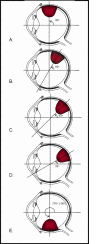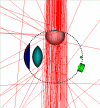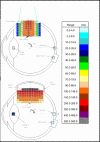Novel low-kVp beamlet system for choroidal melanoma
- PMID: 16965624
- PMCID: PMC1586203
- DOI: 10.1186/1748-717X-1-36
Novel low-kVp beamlet system for choroidal melanoma
Abstract
Background: Treatment of choroidal melanoma with radiation often involves placement of customized brachytherapy eye-plaques. However, the dosimetric properties inherent in source-based radiotherapy preclude facile dose optimization to critical ocular structures. Consequently, we have constructed a novel system for utilizing small beam low-energy radiation delivery, the Beamlet Low-kVp X-ray, or "BLOKX" system. This technique relies on an isocentric rotational approach to deliver dose to target volumes within the eye, while potentially sparing normal structures.
Methods: Monte Carlo N-Particle (MCNP) transport code version 5.0(14) was used to simulate photon interaction with normal and tumor tissues within modeled right eye phantoms. Five modeled dome-shaped tumors with a diameter and apical height of 8 mm and 6 mm, respectively, were simulated distinct positions with respect to the macula iteratively. A single fixed 9 x 9 mm2 beamlet, and a comparison COMS protocol plaque containing eight I-125 seeds (apparent activity of 8 mCi) placed on the scleral surface of the eye adjacent to the tumor, were utilized to determine dosimetric parameters at tumor and adjacent tissues. After MCNP simulation, comparison of dose distribution at each of the 5 tumor positions for each modality (BLOKX vs. eye-plaque) was performed.
Results: Tumor-base doses ranged from 87.1-102.8 Gy for the BLOKX procedure, and from 335.3-338.6 Gy for the eye-plaque procedure. A reduction of dose of at least 69% to tumor base was noted when using the BLOKX. The BLOKX technique showed a significant reduction of dose, 89.8%, to the macula compared to the episcleral plaque. A minimum 71.0 % decrease in dose to the optic nerve occurred when the BLOKX was used.
Conclusion: The BLOKX technique allows more favorable dose distribution in comparison to standard COMS brachytherapy, as simulated using a Monte Carlo iterative mathematical modeling. Future series to determine clinical utility of such an approach are warranted.
Figures








Similar articles
-
Effect of radiation dose on ocular complications after iodine brachytherapy for large uveal melanoma: empirical data and simulation of collimating plaques.Invest Ophthalmol Vis Sci. 2004 Oct;45(10):3425-34. doi: 10.1167/iovs.04-0066. Invest Ophthalmol Vis Sci. 2004. PMID: 15452045
-
Monte Carlo dosimetry modeling of focused kV x-ray radiotherapy of eye diseases with potential nanoparticle dose enhancement.Med Phys. 2018 Oct;45(10):4720-4733. doi: 10.1002/mp.13144. Epub 2018 Sep 21. Med Phys. 2018. PMID: 30133705
-
Dosimetric benefit of a new ophthalmic radiation plaque.Int J Radiat Oncol Biol Phys. 2012 Dec 1;84(5):1226-30. doi: 10.1016/j.ijrobp.2012.01.084. Epub 2012 Jun 1. Int J Radiat Oncol Biol Phys. 2012. PMID: 22658440
-
Review of the poster "Dosimetric comparison of gamma knife radiosurgery vs. 125I plaque brachytherapy in a cohort of choroidal melanomas".Med Dosim. 2009 Summer;34(2):107-9. doi: 10.1016/j.meddos.2008.05.002. Epub 2008 Jun 10. Med Dosim. 2009. PMID: 19410138 Review.
-
Ocular complications following I-125 brachytherapy for choroidal melanoma.Eye (Lond). 2009 Jun;23(6):1254-68. doi: 10.1038/eye.2009.43. Epub 2009 Mar 6. Eye (Lond). 2009. PMID: 19265865 Review.
Cited by
-
Nanoparticle-aided Radiotherapy for Retinoblastoma and Choroidal Melanoma.IFMBE Proc. 2015;51:907-910. doi: 10.1007/978-3-319-19387-8_221. IFMBE Proc. 2015. PMID: 28003818 Free PMC article.
References
-
- Grin-Jorgensen C, Berke A, Grin M. Ocular melanoma. Dermatol Clin. 1992;10:663–668. - PubMed
MeSH terms
LinkOut - more resources
Full Text Sources
Other Literature Sources
Medical

